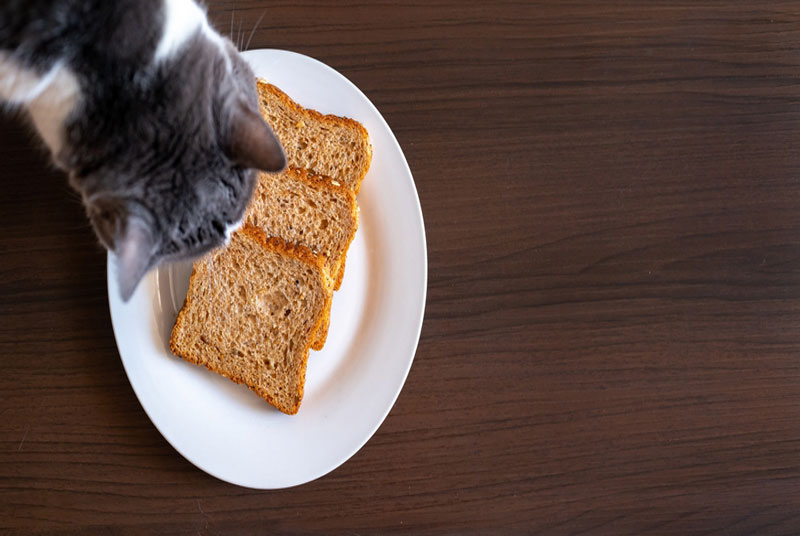Can cats eat bread crust? This is a question many cat owners find themselves pondering, especially when they notice their furry friend eyeing their snack with curiosity and perhaps a hint of hunger. The good news is that yes, cats can eat bread crust in small amounts. It’s not harmful to them, but it’s important to consider moderation and the overall diet of your feline friend.
Understanding whether cats can chow down on bread crust opens the door to a broader discussion about what our adorable companions can and cannot eat. It’s fascinating to explore the dietary needs of cats and how certain human foods fit into their nutrition. As responsible pet owners, it’s vital to share knowledge and ensure our pets have a healthy diet.
So, if you are intrigued and want to learn more about whether your kitty can munch on that leftover bread crust, and what it might mean for their health, keep reading! We are about to embark on a tasty adventure of knowledge together.
Can Cats Eat Bread Crust?

Cats are obligate carnivores, which means that their diet should primarily consist of meat. However, that doesn’t mean their curious little noses won’t lead them to investigate our human food. Bread crust is one such food that may catch their eye, and you may find yourself questioning if it’s safe for them to eat. Generally speaking, a little bit of bread crust is not harmful to your feline friend. While it doesn’t provide any nutritional benefits, a small nibble here and there won’t hurt them.
The crust of bread is typically made from similar ingredients as the rest of the bread, which usually includes flour, water, and yeast. These components are generally safe for cats in small quantities. However, we need to remember that bread is not a natural part of a cat’s diet, and too much can lead to unnecessary weight gain or stomach upset. The key message is moderation; a few tiny bites might be a fun treat, but this should not replace their balanced diet that is specifically formulated for their needs.
How Much Bread Crust Can Cats Eat?
So, how much bread crust can a cat eat? When considering bread crust, we should take a couple of things into account. Firstly, the size of the cat plays a role in how much they can safely consume. A small loaf of crust may seem like a mere snack for us, but for our tiny furry friends, it can feel quite significant. Therefore, the rule of thumb is to keep the portion small. A little bit, like a tiny nibble, is more than enough for their taste buds.
It’s essential to observe your cat’s reaction after trying such a snack. Start with just a crumb or two. If your kitty seems to enjoy it and doesn’t show any adverse reactions—like vomiting or diarrhea—you may consider offering another small piece next time. If your cat is curious, you might find they enjoy the new texture! However, if you find that your cat begins to show any signs of discomfort, discontinue giving them bread crust altogether. And remember, treats should make up no more than 10% of your pet’s daily caloric intake; the majority should still come from their regular food that meets their dietary needs.
It’s also worth noting that if your cat has any underlying health issues such as diabetes or allergies, it would be wise to consult your veterinarian. This way, we can ensure that their diet remains as healthy as possible and that all food treats—yes, even bread crust—are safe for them.
Benefits Of Bread Crust To Cats
1. A little variety in their diet can be fun for cats. Even if bread crust is mostly filler, some cats enjoy the different texture it provides. It can be a nice departure from their usual wet or dry food. Just be careful not to overdo it!
2. Sharing a tiny bit of bread crust can also enhance the bond between you and your cat. Feeding them small treats can create a special moment of connection and trust. It’s essential to engage with your feline friend and involve them in the household activities, including snacking time.
3. For us, watching our pets enjoy a different flavor can be heartwarming. Seeing those little ears perk up at the sound of a bag rustling or bread being torn can bring joy to pet parents. Sometimes just observing them receiving a treat can lift our spirits, making our day brighter.
4. Bread crust can also act as a distraction during grooming sessions or at the vet. If you have a picky kitty who doesn’t like to be handled, having a special treat like bread crust can help ease some anxiety. Just like how we enjoy a chocolate treat while getting through our errands, pets can appreciate a little snack while they endure less fun situations.
5. Lastly, crumbs of bread crust are easy to share! If we have a group of family or friends over, and someone is snacking, offering your cat a tiny piece may add to the fun! Anyone who loves pets knows that sharing little bits at the table can enhance the atmosphere. Remember, just keep it small and safe.
Dangers Of Feeding Bread Crust To Cats
While bread crust may seem harmless, it’s wise to acknowledge that there are risks involved. We certainly do not want to overlook the potential dangers. Cats lack the ability to digest carbohydrates the way humans can. As such, bread and other carb-heavy foods can lead to digestive upset in kitties who aren’t accustomed to it. Think about how we might feel after indulging in a big piece of cake when our usual diet is quite different.
In addition, if bread crust is flavored or contains additional components such as garlic or onion, it can be toxic to cats. It’s crucial to avoid giving your kitty anything that could potentially contain such ingredients, as they can lead to serious health issues. Always err on the side of caution and read the labels of any processed foods before offering it to your furry friend.
There’s also the risk of bread crust contributing to obesity. Cats who consume too many calories through treats put themselves at risk for weight gain, posing further health complications. We understand that keeping a watchful eye on our cat’s weight is critical. If your kitty is on the verge of obesity, watch out for the extra snacks. Bread crust can become an unnecessary source of calories.
Lastly, bread can dry out your kitty’s mouth. If your cat eats too much dry bread crust, it could lead to dehydration, as their water intake might not meet their needs while focusing on munching on the bread. Always ensure fresh water is available, especially when introducing any new food into their diet. We want to keep our kitties healthy and hydrated after all!
Substitute Of Bread Crust For Cats
1. Chicken or Turkey: Instead of bread crust, why not consider giving your cat small pieces of cooked meat? Chicken or turkey can be a great alternative! Cats love protein, and sharing these from our meals is a wonderful way to cater to their natural tastes while ensuring a nutritious snack.
2. Freeze-dried Treats: Another exciting alternative is freeze-dried treats. Many brands offer healthy, protein-laden options suitable for our furry pals. They’re crunchy, tasty, and can become your cat’s favorite treat without the fuss of bread.
3. Fish Snacks: You might also want to explore fish snacks, such as tuna or salmon. Many cats go wild for seafood, and special treats in small portions can be both satisfying and nutritious. Just remember to avoid canned fish packed in oil or containing added ingredients.
4. Fresh Fruits: This can also be a good substitute! Some cats enjoy a little bit of melon or blueberries. These fruits are generally safe in tiny amounts but keep an eye on their reactions, just to ensure everything runs smoothly in their belly.
5. Catnip: Lastly, consider catnip! It’s not edible in the same sense as bread, but catnip can provide entertainment and pleasure for our feline friends. Treating our kitties to some catnip or catnip-infused toys could create a delightful experience without risking their health.
Can Cats Eat Bread Crust? Frequently Asked Questions
Is Bread Crust Safe For All Cats?
Bread crust isn’t inherently dangerous for most cats, but moderation is key. Not all cats have the same dietary tolerance. Always observe your cat after introducing new foods.
What If My Cat Eats Too Much Bread Crust?
If your cat consumes a lot of bread, monitor them closely for signs of discomfort or stomach upset. If they display symptoms such as vomiting or lethargy, consult your veterinarian.
Can Kittens Eat Bread Crust?
It’s best to avoid giving kittens bread crust as their digestive systems are particularly sensitive. They require a specialized diet that supports their growth and development.
What Should I Do If My Cat Is Allergic To Bread?
If your cat shows any signs of an allergic reaction, such as scratching, swelling, or gastrointestinal upset after eating bread, discontinue giving them bread and consult your veterinarian for alternatives.
Are There Healthier Snacks For Cats?
Yes! Healthier alternatives include small pieces of cooked chicken, freeze-dried treats, or even cat-safe fruits like blueberries. Always be attentive with what you share with your furry friends.
Final Thoughts
Feeding bread crust to our cats may seem harmless as a snack, but understanding the nuance behind what we are serving is critical. Our felines thrive best on a diet that mirrors their natural carnivorous instincts, and while an occasional nibble of bread crust can be enjoyable, it should not become a staple. Moderation is essential, and we should always be mindful of their overall health and nutrition. Observing how they react to new foods can make a world of difference. Always keep fresh water available and consult veterinarians when necessary.
We encourage you to keep exploring more about your pet’s dietary needs. You might find other fun snacks to share with your fur babies, like the time we learned if cats can eat chocolate. It’s an adventure we can enjoy together as we uncover what’s best for our furry companions. For more information on pets and their diets, make sure to check out some of our other fun articles: The Ultimate Pet Blog and find out if Can Cats Eat Jelly?. Happy reading!


